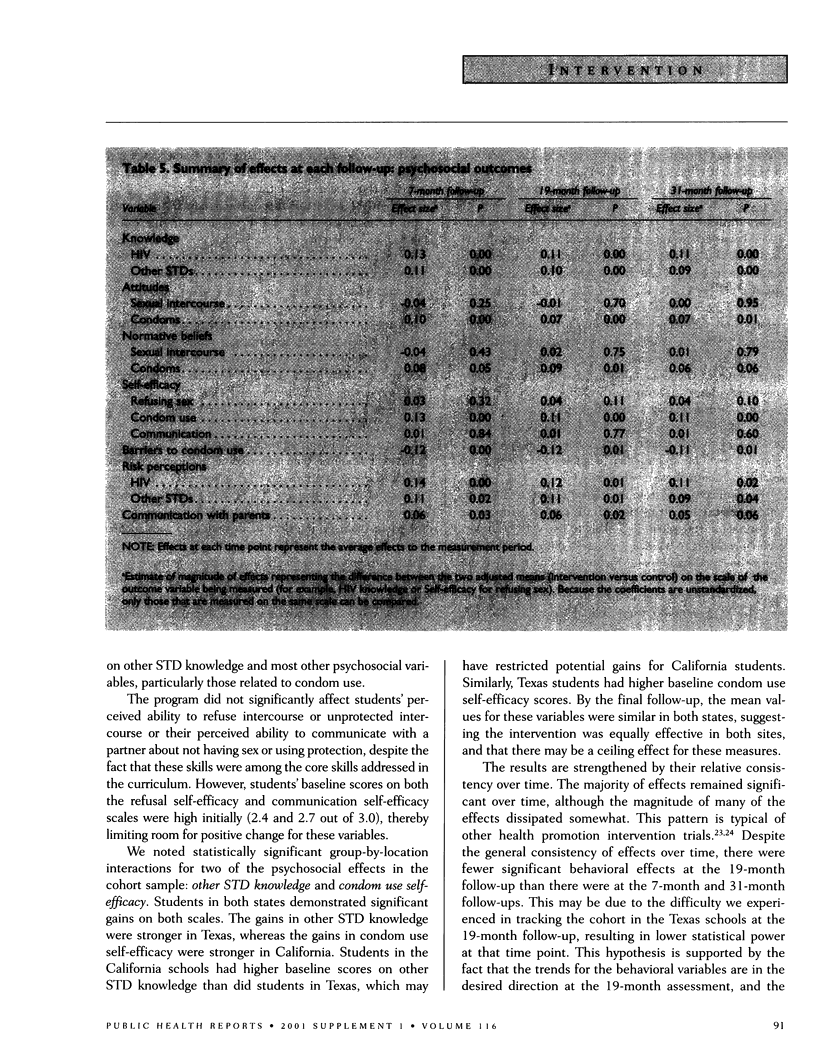Abstract
OBJECTIVES: This study evaluated the long-term effectiveness of Safer Choices, a theory-based, multi-component educational program designed to reduce sexual risk behaviors and increase protective behaviors in preventing HIV, other STDs, and pregnancy among high school students. METHODS: The study used a randomized controlled trial involving 20 high schools in California and Texas. A cohort of 3869 ninth-grade students was tracked for 31 months from fall semester 1993 (baseline) to spring semester 1996 (31-month follow-up). Data were collected using self-report surveys administered by trained data collectors. Response rate at 31-month follow-up was 79%. RESULTS: Safer Choices had its greatest effect on measures involving condom use. The program reduced the frequency of intercourse without a condom during the three months prior to the survey, reduced the number of sexual partners with whom students had intercourse without a condom, and increased use of condoms and other protection against pregnancy at last intercourse. Safer Choices also improved 7 of 13 psychosocial variables, many related to condom use, but did not have a significant effect upon rates of sexual initiation. CONCLUSIONS: The Safer Choices program was effective in reducing important risk behaviors for HIV, other STDs, and pregnancy and in enhancing most psychosocial determinants of such behavior.
Full text
PDF











Selected References
These references are in PubMed. This may not be the complete list of references from this article.
- Basen-Engquist K., Coyle K. K., Parcel G. S., Kirby D., Banspach S. W., Carvajal S. C., Baumler E. Schoolwide effects of a multicomponent HIV, STD, and pregnancy prevention program for high school students. Health Educ Behav. 2001 Apr;28(2):166–185. doi: 10.1177/109019810102800204. [DOI] [PubMed] [Google Scholar]
- Basen-Engquist K., Parcel G. S., Harrist R., Kirby D., Coyle K., Banspach S., Rugg D. The safer choices project: methodological issues in school-based health promotion intervention research. J Sch Health. 1997 Nov;67(9):365–371. doi: 10.1111/j.1746-1561.1997.tb07176.x. [DOI] [PubMed] [Google Scholar]
- Brener N. D., Collins J. L., Kann L., Warren C. W., Williams B. I. Reliability of the Youth Risk Behavior Survey Questionnaire. Am J Epidemiol. 1995 Mar 15;141(6):575–580. doi: 10.1093/oxfordjournals.aje.a117473. [DOI] [PubMed] [Google Scholar]
- Coyle K., Basen-Engquist K., Kirby D., Parcel G., Banspach S., Harrist R., Baumler E., Weil M. Short-term impact of safer choices: a multicomponent, school-based HIV, other STD, and pregnancy prevention program. J Sch Health. 1999 May;69(5):181–188. doi: 10.1111/j.1746-1561.1999.tb06383.x. [DOI] [PubMed] [Google Scholar]
- Coyle K., Kirby D., Parcel G., Basen-Engquist K., Banspach S., Rugg D., Weil M. Safer Choices: a multicomponent school-based HIV/STD and pregnancy prevention program for adolescents. J Sch Health. 1996 Mar;66(3):89–94. [PubMed] [Google Scholar]
- Fisher J. D. Possible effects of reference group-based social influence on AIDS-risk behavior and AIDS prevention. Am Psychol. 1988 Nov;43(11):914–920. doi: 10.1037//0003-066x.43.11.914. [DOI] [PubMed] [Google Scholar]
- Jemmott J. B., 3rd, Jemmott L. S., Fong G. T. Abstinence and safer sex HIV risk-reduction interventions for African American adolescents: a randomized controlled trial. JAMA. 1998 May 20;279(19):1529–1536. doi: 10.1001/jama.279.19.1529. [DOI] [PubMed] [Google Scholar]
- Jemmott J. B., 3rd, Jemmott L. S., Fong G. T. Reductions in HIV risk-associated sexual behaviors among black male adolescents: effects of an AIDS prevention intervention. Am J Public Health. 1992 Mar;82(3):372–377. doi: 10.2105/ajph.82.3.372. [DOI] [PMC free article] [PubMed] [Google Scholar]
- Kim N., Stanton B., Li X., Dickersin K., Galbraith J. Effectiveness of the 40 adolescent AIDS-risk reduction interventions: a quantitative review. J Adolesc Health. 1997 Mar;20(3):204–215. doi: 10.1016/S1054-139X(96)00169-3. [DOI] [PubMed] [Google Scholar]
- Kirby D., Barth R. P., Leland N., Fetro J. V. Reducing the risk: impact of a new curriculum on sexual risk-taking. Fam Plann Perspect. 1991 Nov-Dec;23(6):253–263. [PubMed] [Google Scholar]
- Kirby D., Korpi M., Adivi C., Weissman J. An impact evaluation of project SNAPP: an AIDS and pregnancy prevention middle school program. AIDS Educ Prev. 1997 Feb;9(1 Suppl):44–61. [PubMed] [Google Scholar]
- Levy S. R., Perhats C., Weeks K., Handler A. S., Zhu C., Flay B. R. Impact of a school-based AIDS prevention program on risk and protective behavior for newly sexually active students. J Sch Health. 1995 Apr;65(4):145–151. doi: 10.1111/j.1746-1561.1995.tb06218.x. [DOI] [PubMed] [Google Scholar]
- MCGUIRE W. J., PAPAGEORGIS D. The relative efficacy of various types of prior belief-defense in producing immunity against persuasion. J Abnorm Soc Psychol. 1961 Mar;62:327–337. doi: 10.1037/h0042026. [DOI] [PubMed] [Google Scholar]
- Main D. S., Iverson D. C., McGloin J., Banspach S. W., Collins J. L., Rugg D. L., Kolbe L. J. Preventing HIV infection among adolescents: evaluation of a school-based education program. Prev Med. 1994 Jul;23(4):409–417. doi: 10.1006/pmed.1994.1056. [DOI] [PubMed] [Google Scholar]
- Mitchell-DiCenso A., Thomas B. H., Devlin M. C., Goldsmith C. H., Willan A., Singer J., Marks S., Watters D., Hewson S. Evaluation of an educational program to prevent adolescent pregnancy. Health Educ Behav. 1997 Jun;24(3):300–312. doi: 10.1177/109019819702400304. [DOI] [PubMed] [Google Scholar]
- Resnicow K., Botvin G. School-based substance use prevention programs: why do effects decay? Prev Med. 1993 Jul;22(4):484–490. doi: 10.1006/pmed.1993.1039. [DOI] [PubMed] [Google Scholar]
- St Lawrence J. S., Brasfield T. L., Jefferson K. W., Alleyne E., O'Bannon R. E., 3rd, Shirley A. Cognitive-behavioral intervention to reduce African American adolescents' risk for HIV infection. J Consult Clin Psychol. 1995 Apr;63(2):221–237. doi: 10.1037//0022-006x.63.2.221. [DOI] [PubMed] [Google Scholar]


